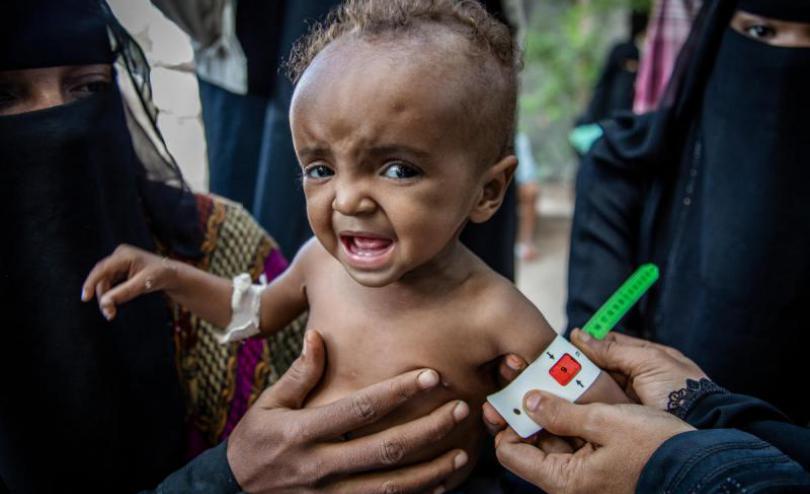One in ten children forced from their homes because of conflict and violence in Yemen

Half a million children displaced by fighting in Hodeidah in just six months
Daoud* (above), 15 months, from Hodeidah, has his arm measured by a health worker at Save the Children’s Outpatient Therapeutic Programme (OTP), in a camp for displaced people (below) in Lahj district, Yemen, where he receives treatment for Severe Acute Malnutrition.
SANAA, 31 January 2019 – At least one in ten children across Yemen (1.5 million) have been forced from their homes because of the four-year-long brutal war, exposing them to serious risks including hunger, disease and violence, warns Save the Children.
More than half a million children have been displaced by the fighting in Hodeidah governorate in just the past six months, according to the UN. That’s an average of more than 2,000 children every single day since June last year. And that’s only from Hodeidah, which has seen some of the worst fighting in Yemen.
Civilians fleeing violence face life-threatening risks the moment they embark on their journeys. The most immediate danger is death or injury due to explosive weapons which have been used indiscriminately by all parties to the conflict with little regard for their legal obligation to protect civilians in conflict.
On August 23rd last year, 22 children and four women were reportedly killed when an airstrike hit their vehicle as they were trying to flee the fighting in Hodeidah. More recently, at least eight civilians were killed in a centre for displaced families in Hajjah, apparently due to shrapnel from shelling nearby. Monitoring group ACLED recorded at least 25 attacks against internally displaced people in just the second half of 2018.
If displaced families manage to survive their dangerous journeys and avoid airstrikes and shelling to reach relative safety, they face further difficulties in strained host communities or in camps lacking in adequate food supplies and basic sanitation and hygiene. This puts young children at risk of malnutrition and disease in a country where the health system has all but collapsed and some 14 million people are on the brink of starvation. Save the Children estimates 85,000 children have already died from extreme hunger since 2015.
Tamer Kirolos, Save the Children’s Yemen Country Director, said:
“In the world’s largest humanitarian crisis, some of the most vulnerable children are those who’ve fled their homes because of the fighting. They’ve been forced out of school and are at risk of exploitation and abuse. We’ve heard stories of children freezing in the cold winter months because they lack adequate shelter and families can’t afford the fuel needed to light a fire. Host communities that were already struggling to survive are under enormous strain, unable to cope with the massive influx of displaced families into their towns and cities. These children have been robbed of their basic rights to life, health and education. They need support now.”
Patrick Watt, global director of Campaign, Advocacy and Communications for Save the Children International, said:
“We welcome a marked decrease in active hostilities on the ground after the warring parties agreed to a ceasefire in Hodeidah last month, but the situation remains tense and Hodeidah port is still not operating at the levels needed to address the urgent humanitarian needs of millions of Yemenis. That translates to children dying from entirely preventable causes because vital food and medicine just aren’t getting into the country. We have seen little evidence that anything has changed for the people of Yemen, especially children, who continue to suffer.
“The international community must ensure the implementation of the Stockholm agreement and take immediate and concrete steps to address the root causes of this man-made humanitarian crisis, including ensuring full and unhindered access of humanitarian and commercial goods and stabilisation of the Yemeni economy.”
Notes to editors:
- The population of Yemen is 28m according to the World Bank. It’s generally assumed that 50% of the population is under the age of 18, so a total of 14m children. The UN estimates there are 2.9m internally displaced people in Yemen, which means approx. 1.5m children, or 10% of the total child population in Yemen.
- OCHA has registered 1,048,302 individuals as internally displaced between 1 June 2018 and 15 January 2019, which means approx. 524,151 children (1,048,302 / 2).
- There are 228 days between 1 June 2018 and 15 January 2019. 524,151 displaced children / 228 days = 2,299 displaced children from Hodeidah per day.




